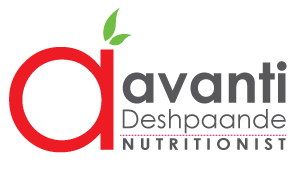
The eating plate should consist of:
- Vegetables and fruits– They should form ½ of your plate as they are rich in fibre both soluble and insoluble. They provide satiety for a longer period and also give the feeling of fullness which is very helpful for those wanting to loose weight. They also avoid insulin spikes and are very helpful in treating some acute constipation. Ideally, one must consume around 300-350g/day of vegetables and fruits.
- Cereals and Nutri-cereals (Millets) – In the other half, almost 1/3rd of this half should be occupied by Cereals and Nutri-cereals. They are carbohydrate-rich foods like Whole wheat, Rice, Rye, Barley, and millets like Foxtail millet, Ragi(Finger millet), Jowar(Sorghum millet), Bajra (Pearl millet), Buckwheat millet (Kuttu), Rajgira(Amaranth millet), Varai(Little millet) and so on. One must consume complex carbs as compared to simpler ones. Millets play a pivotal role in gluten-sensitive enteropathies as they are gluten-free. They are also low GI and rich in fibre. Their recommended intake is around 200-240g/day.
- Pulses, Eggs, and Flesh foods: Major out of the remaining 2/3rd portion consists of protein-rich sources like dals, lentils, eggs, lean meat, fish, etc., and are very important for the structural development of our body. A protein of high biological value is recommended for maximum absorption and utilization. It aids in wear and tear in our body. Also, In this way, all the essential amino acids are supplied to the body. It should be consumed around 90g/day. (Note: Egg/Fish/Meat can substitute pulse on some days)
- Milk and Milk products: They are represented as a glass/bowl outside the plate in the form of buttermilk or curd and are important for achieving the required protein, and calcium, and are the sole source of Vitamin B12 in a vegetarian diet. The ideal intake is around 300 ml of milk or milk products.
- Nuts and Oil seeds: They include invisible sources of fats like MUFA, EPA, and DHA and are very important for optimal brain functioning, growth, and regulation of our fat metabolism in our body. The recommended intake is 30g/day.
- Fats and Oils: These include the smallest portion on the plate and are the visible sources of fat used to improve the palatability and flavors of the food. The consumption should be around 25-27g/day.
The healthy plate method is overall very effective and has many advantages:
- It improves immunity resistance to infections and overall health.
- It also ensures adequate fiber intake thereby ruling out the symptoms of constipation.
- It helps to maintain good gut microbiota (good bacteria in the intestines)
- It prevents insulin spikes and sudden hypoglycemia and maintains proper insulin sensitivity and glycemic control.
- It reduces the risk of Cardiovascular diseases and many other such diseases if coupled with a good exercise regimen.
- It also helps in maintaining the optimum pH of our body and aids in reducing the oxidative stress in our body.
- It maintains the portions under control and also prevents hidden hunger.
Follow on Instagram to stay updated with my healthy plates!

Here are some other Blogs that you should check

Foods to increase the breast milk
Breastfeeding is an extremely crucial period for both mother and baby. It provides the baby with essential nutrients and antibodies while helping the mother bond

How to improve Hemoglobin during Pregnancy
Pregnancy is a time of profound change in a woman’s body, with various physiological adjustments necessary to support the growing fetus. One crucial aspect of

Top 10 Mistakes in Weight Loss and Intermittent Fasting.
There is a lot of talk about Intermittent fasting these days. Intermittent fasting has become a popular and effective strategy for many people aiming to

How to Balance Hormones for Weight loss
When it comes to weight loss, most people often focus on diet and exercise. They meticulously count calories, track macros, and spend hours at the

Difference between PCOS & PCOD
Polycystic Ovarian Syndrome (PCOS) and Polycystic Ovary Disease (PCOD) are two terms often used interchangeably, but they represent distinct conditions with unique characteristics. While they

Role of Antioxidants in Gut Health
In our body’s complex system, the gut plays a central role in orchestrating various functions essential for overall health. Recent breakthroughs in scientific research have

